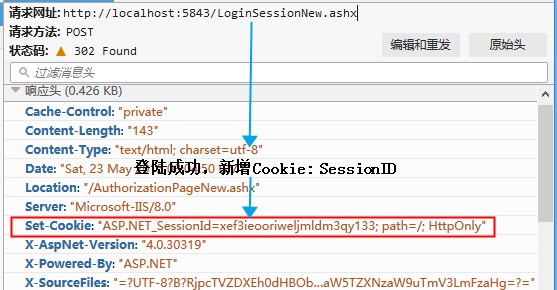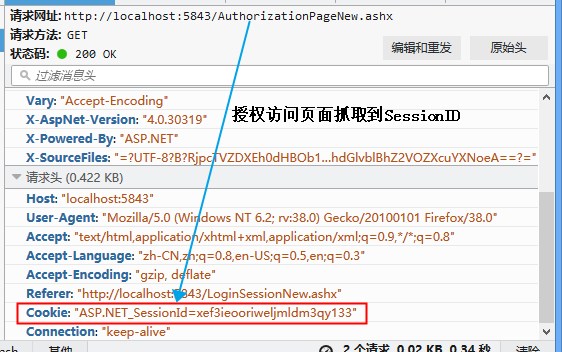1,HTTP協議是無狀態的。服務器不會記住上次給浏覽器的處理結果,如果需要上次處理結果(上次狀態)就需要浏覽器把處理結果值(上次狀態)再次給服務器。
2,URL傳值:通過URL參數或者通過Form表單進行頁面件的傳值 (不能做到很自由的存取和讀取,而且不安全)
3,Cookie :①Cookie可以用來進行更加自由的數據的存取和讀取。
②Cookie是和站點相關的,自己域名寫的只有自己的域名才可以讀取。
③客戶端向服務器發送請求的時候 處理發送Form表單信息以外還會把和站點有關的所有的Cookie發送給服務器,是強制的。
④服務器返回的數據處理HTML數據以外,還會返回修改的Cookie,浏覽器拿到修改後的Cookie更新到本地的Cookie
⑤服務器端使用Cookie案例,記住用戶名功能:
A,設置頁面值: Response.SetCookie(new HttpCookie("UserName",username))
B,讀取頁面值: username=Request.Cookies["UserName"].Value
⑥浏覽器關閉以後Cookie的聲明周期到期,也就是Cookie的默認生命周期是浏覽器的生命周期。可以通過設置Expires屬性設置Cookie的過期時間:Cookie.Expires=DateTime.Now.AddDays(-1)
⑦Cookie在客戶端是以鍵值對存在的
4,Cookie缺點:①客戶端額可以手動清楚Cookie 所以Cookie裡面存放的信息是可有可無的信息
②浏覽器對 Cookie 的大小有限制,因此只有不超過 4096 字節才能保證被接受
③機密信息不能放到Cookie裡面
④Cookie不能跨浏覽器
5,Cookie的寫和讀: A,新建CookieTest.html頁面並添加 兩個按鈕分別用於Cookie的讀和寫
<!DOCTYPE html>
<html xm lns="http://www.w3.org/1999/xhtml">
<head>
<me ta http-equiv="Content-Type" content="text/html; charset=utf-8" />
<title></title>
</head>
<body>
<form>
<in put type="submit" name="Read" value="讀取Cookie" />
<in put type="submit" name="Write" value="寫入Cookie" />
<br />
讀取出來的Cookie: $Model.CookieValue
</form>
</body>
</html>
B,建立對應的CookieTest.ashx頁面 實現Cookie的新建寫入本地以及讀取Cookie的值
using System;
using System.Collections.Generic;
using System.Linq;
using System.Web;
namespace HttpNoStatus
{
/// <summary>
/// HttpCookie 的摘要說明
/// </summary>
public class CookieTest : IHttpHandler
{
public void ProcessRequest(HttpContext context)
{
context.Response.ContentType = "text/html";
//if else 判斷是點擊的那個按鈕
if (!string.IsNullOrEmpty(context.Request["Read"]))
{
if (context.Request.Cookies["Age"] != null)
{
HttpCookie cookie = context.Request.Cookies["Age"];
string strValue = cookie.Value;
var data = new { CookieValue = strValue };
//加載模板頁面並傳遞 Cookie Value的值
string strHtml = Common_Nvelocity.RenderHTML("CookieTest.html", data);
context.Response.Write(strHtml);
}
else
{
context.Response.Write("cookie 不存在");
}
}
else if (!string.IsNullOrEmpty(context.Request["Write"]))
{
//寫入新的Cookie
HttpCookie acookie = new HttpCookie("Age");
acookie.Value = "25";
acookie.Expires = DateTime.MaxValue;
context.Response.Cookies.Add(acookie);
//Cookie不存在 直接加載模板頁面
string strHtml = Common_Nvelocity.RenderHTML("CookieTest.html", null);
context.Response.Write(strHtml);
}
else
{
//第一次加載頁面
string strHtml = Common_Nvelocity.RenderHTML("CookieTest.html", null);
context.Response.Write(strHtml);
}
}
public bool IsReusable
{
get
{
return false;
}
}
}
}
6,Cookie最主要的一個功能是保存用戶的登陸名,這樣用戶在下次登陸的時候系統就可以自動填寫登陸名稱
A,新建LoginCookie.html頁面,頁面中添加我們經常見到的 用戶名,用戶密碼,登陸
登陸頁面第一次加載的時候,設置默認的登陸名為空,登陸成功以及再次登陸的時候系統就自動補充登陸用戶名
<!DOCTYPE html>
<html xm lns="http://www.w3.org/1999/xhtml">
<head>
<me ta http-equiv="Content-Type" content="text/html; charset=utf-8" />
<title></title>
</head>
<body>
<form action="LoginCookie.ashx" method="post">
<table>
<tr>
<td>登陸名</td>
<td>
<in put type="text" name="UserName" value="$Model.LoginUser" /></td>
</tr>
<tr>
<td>密碼</td>
<td>
<in put type="password" name="Password" /></td>
</tr>
<tr>
<td>
<in put type="submit" name="Login" value="登陸" /></td>
<td></td>
</tr>
</table>
</form>
</body>
</html>
B, 新建對應的LoginCookie.ashx頁面,實現把用戶名讀取出來並寫入Cookie "ckLoginUser"
using System;
using System.Collections.Generic;
using System.Linq;
using System.Web;
namespace HttpNoStatus
{
/// <summary>
/// LoginCookie 的摘要說明
/// </summary>
public class LoginCookie : IHttpHandler
{
public void ProcessRequest(HttpContext context)
{
context.Response.ContentType = "text/html";
//加載頁面直接顯示 頁面
if (context.Request.Form["Login"] == null)
{
string strHtml = "";
var data = new { LoginUser = "" }; //登陸賬號默認為空
//判斷Cookie是否存在,如果存在 把Cookie的值傳遞到HTML頁面,如果不存在就是默認的空
if (context.Request.Cookies["ckLoginUser"] != null)
{
data = new { LoginUser = context.Request.Cookies["ckLoginUser"].Value.ToString() };
}
strHtml = Common_Nvelocity.RenderHTML("LoginCookie.html", data);
context.Response.Write(strHtml);
}
else
{
//用戶登陸,保存用戶名到Cookie
HttpCookie LoginUser = new HttpCookie("ckLoginUser");
LoginUser.Value = context.Request.Form["UserName"];
LoginUser.Expires = DateTime.Now.AddDays(30);
context.Response.Cookies.Add(LoginUser);
//加載頁面直接顯示 頁面
string strHtml = Common_Nvelocity.RenderHTML("LoginCookie.html", new { LoginUser = context.Request.Form["UserName"] });
context.Response.Write(strHtml);
}
}
public bool IsReusable
{
get
{
return false;
}
}
}
}
7,以上方法把登陸賬號以Cookie的形式存放在客戶端,這樣每一次的請求就可以帶出用戶登陸名稱了
有一種情況: 用戶登陸成功以後就可以訪問網站的其他所有頁面,其他頁面就需要先判斷用戶是否登陸成功。
如果登陸成功為True放到Cookie中,這樣的客戶端就可以進行篡改把False改為True從而可以非法訪問為授權頁面了,這樣放到Cookie就不安全了。
如果登陸成功放到服務器端,那麼網站的多個頁面就可以直接讀取到這個值,而且是安全的不會被客戶端篡改的了。
8,Session原理: 把數據Value值存儲在服務器端並在客戶端存放Value對應的ID 。(ID,Value)都存放服務器 另外把ID以Cookie的形式存放客戶端。這樣就可以從客戶端Cookie中抓取ID,然後從服務器端讀取到ID對應的Value。
10,下面示例以Session原理實現頁面判斷用戶是否有成功登陸:成功登陸的用戶可以對特定頁面進行訪問、如果沒有成功登陸就跳轉到登陸頁面。
A. 添加類 SessionMgr.cs 在服務器端存儲 鍵值對 ID/Value
using System;
using System.Collections.Generic;
using System.Linq;
using System.Web;
namespace HttpNoStatus
{
public class SessionMgr
{
//定義鍵值對,存儲登陸信息
private static Dictionary<Guid, string> KeyValue = new Dictionary<Guid, string>();
//設置鍵值對的值
public static void SetKeyValue(Guid id, string value)
{
KeyValue[id] = value;
}
/// <summary>
/// 檢查客戶端傳遞過來的鍵值對是否存在
/// </summary>
/// <param name="id"></param>
/// <returns></returns>
public static bool IfIdExist(Guid id)
{
return KeyValue.Keys.Contains(id);
}
//返回服務器端ID對應的Value值
public static string GetValue(Guid id)
{
return KeyValue[id].ToString();
}
}
}
B. 添加 LoginSession.ashx 判斷用戶是否登陸成功,如果登陸成功把存儲對應的鍵值對的值
using System;
using System.Collections.Generic;
using System.Linq;
using System.Web;
namespace HttpNoStatus
{
/// <summary>
/// LoginSession 的摘要說明
/// </summary>
public class LoginSession : IHttpHandler
{
public void ProcessRequest(HttpContext context)
{
context.Response.ContentType = "text/html";
string strHtml = "";
//讀取用戶名和密碼
string strUserName = context.Request.Form["txtUserName"];
string strPwd = context.Request.Form["txtPassword"];
if (strPwd == "123456")
{
//登陸成功,設置對應的鍵值對
Guid id = Guid.NewGuid(); // 產生唯一的ID
SessionMgr.SetKeyValue(id, strUserName);
//id 保存在客戶端cookie中
HttpCookie loginCookie = new HttpCookie("LoginCookie");
loginCookie.Value = id.ToString();
loginCookie.Expires = DateTime.Now.AddDays(7);
context.Response.Cookies.Add(loginCookie);
//跳轉到授權頁面
context.Response.Redirect("AuthorizationPage.ashx");
}
else
{
//登陸失敗 , 加載登陸頁面
strHtml = Common_Nvelocity.RenderHTML("LoginSession.html", null);
context.Response.Write(strHtml);
}
}
public bool IsReusable
{
get
{
return false;
}
}
}
}
C. Templates文件夾下添加LoginSession.html 登陸頁面
<!DOCTYPE html>
<html xm lns="http://www.w3.org/1999/xhtml">
<head>
<me ta http-equiv="Content-Type" content="text/html; charset=utf-8" />
<title></title>
</head>
<body>
<form action="LoginSession.ashx" method="post">
<table>
<tr>
<td>登陸名</td>
<td>
<in put type="text" name="txtUserName" /></td>
</tr>
<tr>
<td>密碼</td>
<td>
<in put type="password" name="txtPassword" /></td>
</tr>
<tr>
<td>
<in put type="submit" name="Login" value="登陸" /></td>
<td></td>
</tr>
</table>
</form>
</body>
</html>
D. 添加AuthorizationPage.ashx頁面,只有登陸後的賬戶才有權限訪問這個頁面
using System;
using System.Collections.Generic;
using System.Linq;
using System.Web;
namespace HttpNoStatus.Templates
{
/// <summary>
/// AuthorizationPage 的摘要說明
/// </summary>
public class AuthorizationPage : IHttpHandler
{
public void ProcessRequest(HttpContext context)
{
context.Response.ContentType = "text/html";
//抓取客戶端 Cookie的ID值
HttpCookie loginCookie = context.Request.Cookies["LoginCookie"];
if (loginCookie != null)
{
Guid id = new Guid(loginCookie.Value);
// 讀取id對應的Value
string strValue = SessionMgr.GetValue(id);
//輸出Value值,並提示該賬號是已經登陸的賬號
context.Response.Write(strValue + ",您已經登陸本網站,有權限訪問此頁面");
}
//如果Cookie不存在,則直接跳轉到登頁面
else
{
context.Response.Redirect("LoginSession.ashx");
}
}
public bool IsReusable
{
get
{
return false;
}
}
}
}
------------------------------------------------------------gif 動畫演示----------------------------------------------------------------

11,上面的示例是也就是Session原理。Asp.net已經內置了Session機制,下面我們直接用ASP.NET Session實現 判斷用戶是否有登陸成功:
(一般處理程序HttpHandler操作Session, 要實現IRequiresSessionState接口)
分別添加頁面: LoginSessionNew.ashx(登陸一般處理程序) , LoginSessionNew.html(登陸模板), AuthorizationPageNew.ashx(登陸後才有權限訪問的頁面)。
A,LoginSessionNew.ashx(登陸一般處理程序)
using System;
using System.Collections.Generic;
using System.Linq;
using System.Web;
using System.Web.SessionState;
namespace HttpNoStatus
{
/// <summary>
/// LoginSessionNew 的摘要說明
/// </summary>
public class LoginSessionNew : IHttpHandler, IRequiresSessionState
{
public void ProcessRequest(HttpContext context)
{
context.Response.ContentType = "text/html";
string strHtml = "";
//讀取用戶名和密碼
string strUserName = context.Request.Form["txtUserName"];
string strPwd = context.Request.Form["txtPassword"];
if (strPwd == "123456")
{
//登陸成功,直接保存Session值
context.Session["LoginUserName"] = strUserName;
//跳轉到授權頁面
context.Response.Redirect("AuthorizationPageNew.ashx");
}
else
{
//登陸失敗 , 加載登陸頁面
strHtml = Common_Nvelocity.RenderHTML("LoginSessionNew.html", null);
context.Response.Write(strHtml);
}
}
public bool IsReusable
{
get
{
return false;
}
}
}
}
B,Templates模板下新建LoginSessionNew.html(登陸模板)
<!DOCTYPE html>
<html xm lns="http://www.w3.org/1999/xhtml">
<head>
<me ta http-equiv="Content-Type" content="text/html; charset=utf-8" />
<title></title>
</head>
<body>
<form action="LoginSessionNew.ashx" method="post">
<table>
<tr>
<td>登陸名</td>
<td>
<in put type="text" name="txtUserName" /></td>
</tr>
<tr>
<td>密碼</td>
<td>
<in put type="password" name="txtPassword" /></td>
</tr>
<tr>
<td>
<in put type="submit" name="Login" value="登陸" /></td>
<td></td>
</tr>
</table>
</form>
</body>
</html>
C,AuthorizationPageNew.ashx(登陸後才有權限訪問的頁面)
using System;
using System.Collections.Generic;
using System.Linq;
using System.Web;
using System.Web.SessionState;
namespace HttpNoStatus
{
/// <summary>
/// AuthorizationPageNew 的摘要說明
/// </summary>
public class AuthorizationPageNew : IHttpHandler, IRequiresSessionState
{
public void ProcessRequest(HttpContext context)
{
context.Response.ContentType = "text/plain";
//檢查Session是否存在
ob ject obj = context.Session["LoginUserName"];
if (obj != null)
{
//Session存在,讀取Session值,並提示該賬號是已經登陸的賬號
context.Response.Write(obj.ToString() + ",您已經登陸本網站,有權限訪問此頁面");
}
//如果Session不存在,則直接跳轉到登頁面
else
{
context.Response.Redirect("LoginSessionNew.ashx");
}
}
public bool IsReusable
{
get
{
return false;
}
}
}
}
· ASP.NET內置Session機制同樣實現了對用戶是否登陸成功的判斷:LoginSessionNew.ashx頁面Headers中我們看到了Cookie中多了ASP.NET_SessionId
Session機制在客戶端存放了ASP.NET_SessionID

· 權限訪問頁面,請求頭中讀取到了客戶端Cookie中的ASP.NET_SessionID

12, ASP.NET的Session機制: Session依賴於Cookie , 借助Cookie在客戶端浏覽器中記錄了ID, 在服務器端存儲了Value值。
13,Session的值是放到了服務器內存中,所以Session存放小數據。
Session(會話)有自動銷毀機制,如果一段時間內浏覽器沒有和服務器交互,則Session會定時自動銷毀。
登陸賬號後,一段時間內如果不操作 系統就會自動退出,這就是Session自動銷毀了。